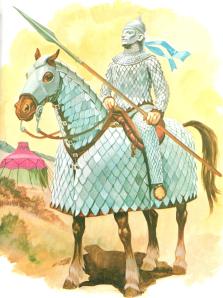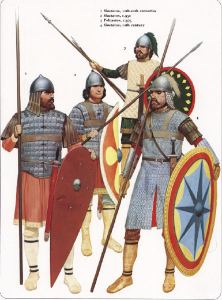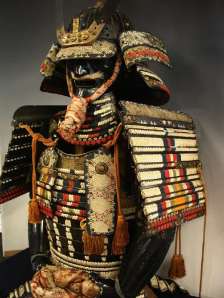
Joan of Arc, the Maid of Lorraine will be your instructor for today. She expects you to be on your most pious behavior.
Joan D’Arc here, and I welcome you to Minimum Wage Historian. Zach is busy trying to get one of his novels ready for submission. I don’t understand it but he feels it is important. I’ll let God judge. First I will start with a prayer and a few hymns. (Edited for time by staff.) There, now that that’s…did you edit that out? Don’t shake your heads at me. I know you did. God will punish you for lying. But time is short so I will continue on, trusting that the Lord will guide us.
Our topic today is very interesting to me, Quoi? The evolution of armor. As you know, I fought wearing a sophisticated suit of full plate. But, how did we arrive at a point where we fully enclose a soldier in a skin made of metal? How long was that the case. I understand that many of you in the 21st century have a somewhat romantic and inaccurate notion of what warfare was like in the middle ages. Many have a vague idea of knights in full plate saving damsels in distress for a few hundred years. No so. For one, chivalry had more to do with not killing and instead ransoming knights than being kind to women. But, back to the topic, what did knights wear? How long was the era of the “knight in shining armor?”
Let’s start at the beginning.

This is one of the earliest known suits of armor. As you can see it is quite heavy looking and not very mobile. It was made for the nobility riding on chariots. Not the armor of an infantryman.
The Greeks also used body armor, helmets and large shields. But let us go to the Romans. We’ll mainly be discussing European arms and armor, so we will look to the Romans because Western ideas of military come from the Romans.
The Romans managed to mass produce on a scale that had never been seen before, a plate mail body armor for the average soldier. It was made of rings that formed segments like an insect. It was called “Lorica Segmetata” and has come to symbolize the Roman Legions.

Here we see the Lorica Segmentata from the ancient catalog “Calvinus Klienus” Mass produced, heavy armor that also offered great mobility.
But, was this how it was?

The Romans also used a great deal of other types as well such as mail (seen above) scale and llamalar. Scholars like to argue back and forth about what percentage of troops actually used segmentata and it was only around for about 200 years.
The Romans could have developed heavier armor but they preferred mobility. However, there are examples of Legions using heavier armor in addition to the segmentata.

Here we see a Roman soldier with his arm covered in flexible metal plates. Could the Romans have developed full plates like I wear? Sure. Did they choose to? No.
As has been stated in previous posts, the legions evolved into something else, something more…Medieval for lack of a better word. Let’s look at armor at the end of the Empire and the beginning of the Dark Ages. Many of the heathen barbarians that overtook Rome copied Roman equipment and ways of war and the Romans also copied barbarian equipment and ways of war so that at the end, they became one and the same.

Here is an Alan warrior. Shave his beard and cut his hair and he would pass for a Roman soldier at the time. Chain mail shirts (inferior to segmentata but easier to produce.) The helmets became simplified conical shapes that were more robust and offered better protection than legionary helmets of the segmentata, but were also easier to make.

Here’s a Goth warrior. Conical helmet, yes indeed. Chain mail shirt? Yes. Round shield? Yes. This is a style that will last quite a long time as you shall see.
Now we move on to the sixth century.

Here is one of my beloved French..er…Frankish soldiers. Not much had changed in terms of arms and armor from the last century.
In western Europe, amid the ruins of the Empire, the armor remained principally the same. So, let us look further east to some variations of armor at this time.

The surviving Eastern Romans took an entirely different route and produced very heavily armored cavalry and lightly armored infantry, almost foreshadowing what would later occur in Western Europe.

Over in Eastern Europe, the Slavs had their own style as well which was similar to both Western and Byzantine forms and would parallel the Byzantines for the most part.
Now, on to the 7th century!

This most noble Frankish knight is wearing chain armor that goes further down the legs to the knees and also now has a hood that goes under the even more simplified conical helmet. (No more chin pieces for the helmets.)

Here is a 7th century helmet clearly meant for a very important person. It is fully enclosed. Very rare type of helmet for this period. Similar to what Viking nobility would wear.
Now the 8th!

Western Europe hasn’t changed so we look to the Ummayads in Egypt. Oh, my. What do we have here? Chain shirts and conical helmets. Where else might we find this style that has so far lasted four hundred years?

Here we have an Indian warrior. Chain shirt, but the helmet is not quite the same, though there are examples of conical types. Could there have been exchange of military ideas from France all the way to India? (the answer’s yes, by the way)
On to the 9th Century!

Still the same with some minor geographical differences. Here is a German soldier. Not only does he have a hood, he also has chain armor to cover his face.
Where else might we see chain armor covering a face?
Let’s see what happens in the 10th century.
Oh…well…still, not much has changed, so we’ll look at the Byzantines. Anna will yell at me if she hears me calling them “Byzantines.”

Not heavy like the catophracts, but still similar in function to what the Franks, Italians and Germans were using.
On to the 11th
In the 12th things finally start the change, mostly due to the Crusades. They came in contact with different cultures and different ideas and began adapting and changing.

Here is a 12th century Tuetonic Knight. Now the chainmail covers the arms and legs, but the helmets have grown as well! This is a “great helm” and covers the entire head.

In Japan the armor was large and elaborate. Their armor would grow smaller and more simplified as time goes on and even adapt western styles to it. (Look at Tokugawa armor at the Battle of Sekigahara for an example of this.)
The 13th century things really start to change. Armor starts to become more substantial and helmets more elaborate.

Not only is the knight covered head to toe in mail, he’s also wearing a more refined great helm and more protection around the torso.

We also see the start of this bird helm style of armor. Note the use of metal plates covering the limbs. The torsos have the Brigandine armor that has a leather facing lined with metal strips. The armor is becoming more protective and more sophisticated.

Over in China they were also using chain mail but sometimes with extra plates sewn in for added protection. The use of helmets was also common. (But with a stylish flair of red!)
Now to the 14th!
Let’s now go to my century, the 15th, the second century of the Hundred Years War.

Fully evolved full plate armor. This was a suit used for battle. Simple and unadorned like mine! It is tailor made to fit the individual to allow the greatest fit and mobility.

Here is a decorated suit of German Gothic armor. Keep in mind that these full plate armors were far more agile and maneuverable than you might think.
In the 16th century armor takes a different turn. The armor becomes heavier to deal with improved firearms, but also begin to cover less of the body.

Still full plate and often articulated even more than the previous century, but it’s starting to ignore the legs and face. The torso is tapered like so to hopefully deflect projectiles.
17th century

Here are three types of 17th century armor. Now it is heavier but mostly in the torso and head only. Rare occasions of heavy cavalry would wear a very heavy and costly armor. (the middle one.) But that was not what the common knight, man at arms or soldier would wear. The advance of fire arms is slowly making armor obsolete. (and making the nobility more flamboyant in civilian dress to compensate for their lack of battlefield panache!)
And the 18th century.

In the eighteenth century, only the Polish Hussars would wear full plate. Most of Europe considered it terribly old fashioned by then but the Polish hussars turned it into a psychological weapon and would be terrifying as they charged.

See? Very terrifying. I would be terrified but I am French! Why are the staff laughing. I don’t understand.
So, the time of men and women fighting in suits of metal armor came to a close. Full plate lasted only a couple of centuries and for most of the Dark and Middle Ages it was chain mail and conical helmets. So, no more body armor.
But is it the end?

Oh! What is Zach wearing there? Helmet, shoulder protection and hard body armor! We have come back to the theory of the Lorica Segmentata and the Roman Legions. Hard, protective, mass produced body armor that allows great mobility. My, how things have changed.
This has been your host, Joan D’Arc, closing with a mass, a few prayers and a few hymns. We’ll start with…(transmission cut due to technical difficulties.)
Gaspar Corriea here for a reminder to look at Zach’s book. (looks at card) It’s a post apoca..apoclypse..something or other adventure about a girl that heads out across a wasteland America in search for her brother. Olga says it didn’t have enough burning things in it but it does have lots of shooting so I liked it. Give it a try! Available for paperback and Kindle.










Tell Joan of Arc that she shouldn’t be surprised about the modern day armor. I mean, fashion is cyclical….
This is one of your best articles yet. Keep it up!
Stupid question… Why are you rocking a 20 round mag in your M4?
Well, I was the driver and where I stowed my M4 it was easier to have a 20 rounder.
Fair enough. 🙂
lol
Swift and clear! I only missed a bit of the WW1 armour revival. By the way, I have always wondered how much weights a “combat kit” like yours (armour and weapons plus ammo). Can you answer that?
The armor weighed about 20-30 pounds depending if you had side plates in, which we did. M4, around 8 pounds fully loaded. Water, another 2 pounds. Backpack full of random but useful stuff, another 10 pounds. So, about 50 pounds.
Why was drawing wire, making tiny rings, hooking them together in the proper pattern, and then putting tiny rivets through them easier than hammering out lames for a segmentata?
It was more time consuming, but required less skill to make than lorica segmentata, so any peasant working in a shop could make it. Segmentata required someone of skill to make. Also, it was much easier to maintain chain mail in the field. The soldiers could patch it up themselves if they had a few extra rings handy. But one of the reasons the Romans moved from Segmentata to chain was that the legions became localized so they began using what the locals could make, which was barbarian chain mail and helmets. Then full on Maximillian plate mail required a true master craftsman to make.
This is very interesting. My question is whether segmentata is superior to mail. Any research on that?
It’s superior in that it stops more than just slashing attacks. Chainmail is very weak against peircing, such as spears and arrows. Segmentata stops slashing, blunt and piercing and it’s mobile enough not to hinder the wearer to a great degree.
As the man said any body could forge a piece of metal into a ring for mail. bear in mind most available metal was recycled from where ever (there’s a shocker the last government didn’t invent recycling ) or new rough ingots if you had the money. I’m fairly good with a hammer but I think I would struggle to make even a half presentable breast plate if I didn’t have a supplier for sheet metal
Good to have an experienced opinion. A solid breastplate is really that hard to make? Interesting. I’d love to learn more. Matilda of Tuscany is also curious. She wants to try on a full plate suit.
There are couple small errors there and here, but otherwise good article…
Hi MWH
would you please explain “Matilda of Tuscany … wants to try on a full plate suit”
13centurys last chain mails are from korea. its not from china. I sow it in korean war museum in seoul. it that chain mails are from goryeo an ancient korean state.
im not good at english so dont refute to me -.-
Korea, huh? Interesting. I’ll have to take a look at that. Thanks for the heads up!
I am amused. Many of your pictures are from the SCA.
Um…didn’t kite-shaped shields appear in the 10th century?
Awesome, awesome, awesome.
Another that would be cool is the timeline of weapons and we could see the arms race back and forth between armor and weapons.
yeah, whats the arms race that kept the same armor style for the first 1000 years?
you forgot the longbow affect lol
Its clear from whatever this is that you sir, are no Historian. I know nothing whatsoever about you so forgive my next assertion Judging by your ‘pigs’ comment about the English, you surely must be French? .I accept that your pre-modern history may not be up to scratch, but let me educate you on a piece of slightly more recent History, we (the English) did a great deal to help if not save your country in two World wars. So the worn-out Medieval sentiment that the two nations must feel some unjustified animosity towards each other is bizarre to me.
Bonjour! Tis I, Joann D’Arc, ze author of zis article zat you do not like. You, sir, are correct about two things. Yes, I am Medieval and I am, by ze grace of heaven, French! Perhaps I am no scholar, but, as I have fought in many battles, I felt qualified to talk about such things. I wielded ze sword at Orleans! I waved my banner at ze walls of Paris! I thought you English dogs were supposed to be smart and funny.
great article